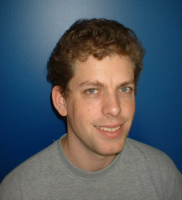On the Energetics and Dynamics of Cu (001) and Co/Cu (001)
Promotion date: 16-04-2004
| Half of my thesis is a theoretical model and the other half is about diffusion research and the embedding of cobalt atoms on copper substrate. There was a general model for the copper substrate, but I added an extra interaction which allowed us to make a detailed analysis of the energetics. The steady decrease of cobalt atoms resulted in all kinds of different interactions. With a minimum of cobalt atoms we saw that they moved about and eventually stabilized in clusters. The relevance for this kind of research is the magnetic properties of the cobalt, which could be an interesting fact for industry. |
What was your thesis about?
Half of my thesis is a theoretical model and the other half is about diffusion research and the embedding of cobalt atoms on copper substrate. There was a general model for the copper substrate, but I added an extra interaction which allowed us to make a detailed analysis of the energetics. The steady decrease of cobalt atoms resulted in all kinds of different interactions. With a minimum of cobalt atoms we saw that they moved about and eventually stabilized in clusters. The relevance for this kind of research is the magnetic properties of the cobalt, which could be an interesting fact for industry.
Was there a definite conclusion?
We developed a very good model for the substrate, a solid on solid model enabling easy calculations. We also established that the cobalt atoms are inclined to interchange which may lead in future to the production of one atom magnetic layers on a substrate.
And our research was new in the sense that we worked on an unparalleled small scale.
Is there a practical application?
The research is basically purely fundamental, but later it may be possible to use the knowledge of the interactions in the manufacturing process of hard disks for instance.
How did you conduct your research, working with atoms?
I used an STM, a scanning tunnelling microscope. That is a microscope with a tip that scans the atoms, and with specific computer techniques you can ‘see’ the atoms on the surface.
What did you enjoy most during those four years?
Well, on a personal level: I got married and became a father of a daughter, and professionally I enjoyed the independence of the work. The specific focus of the research allowed looking into every small detail, which I find interesting. Also going to conferences is very stimulating, because having to write up your findings clears your mind and makes you to consider the problem from different angles. And it was very gratifying to find that phenomena for this substrate which could not be explained before, fit splendidly into this new theory.
What didn’t you like about the past four years?
Being involved in the Enschede fireworks disaster. I lived in the centre of the area where the explosion occurred. Nothing was left of my house. It is completely gone, with everything in it. Fortunately I wasn’t there at the time, being on holiday in Belgium. But we went back to nothing at all.
Did you lose any scientific material?
No, of course I did some work at home as well, but I am good at making backups, as everybody should be I think. All my research results were at the university. But emotionally it is quite a shock that takes a while to wear off.
We stayed with a colleague of mine for about 1,5 months. After that we got a house.
I do hear a slight accent, are you from Belgium?
Well, the nationalities in my life are quite a story. I was born in France, have the Belgian nationality, I did my master’s in Australia and will go there again, my wife was born in Madrid and a descendent from Chile and my daughter was born in the Netherlands and had no nationality at all for two weeks. Now she is Australian.
What are you going to do I Australia?
I am going to lecture at a university, half an hour from Sydney where I did my master’s.
It may seem quite a change from fundamental research to the down to earth practice of teaching, but I always wanted to be a lector at a university. And to be able to do that you first have to make your contribution to science and do a promotion research.
If becoming a university lecturer was the purpose of your promotion, couldn’t you have chosen an easier subject?
There are no easy subjects in a promotion research. You do have to come up with something new and show that you are capable to do independent research. You would not get away with half work: your promotor also has a scientific reputation to keep up.
What do you specifically like about lecturing?
Physics were the only constant factor in my life. I travelled a lot in my youth, we lived in different places, languages changed all the time but mathematics and physics were the same everywhere. It is the love for the subject that I want hand on. And I know that I am a good teacher.

